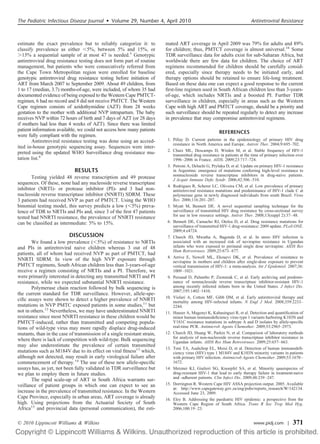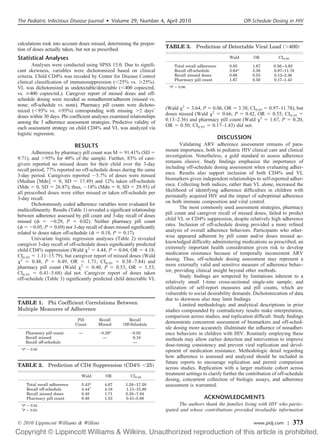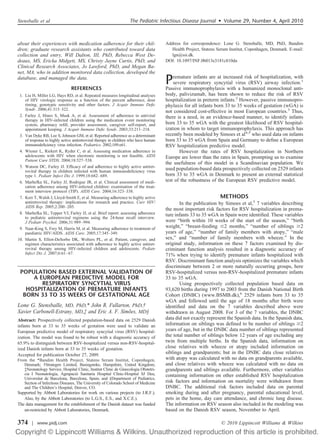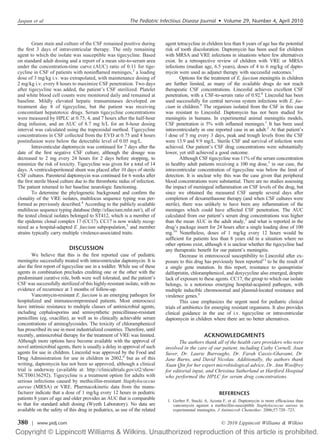This document summarizes a study of 11 preterm infants with severe human rhinovirus (HRV) infections. Key findings include:
1) Nine of the 11 infants were preterm (median gestational age of 30 weeks) and 7 of the 9 preterm infants acquired HRV during their stay in the neonatal intensive care unit (NICU).
2) All infants presented with respiratory distress and required respiratory support like mechanical ventilation for a median of 6 days. Chest x-rays showed findings like perihilar streakiness and atelectasis.
3) HRV infection was diagnosed using real-time polymerase chain reaction testing of nasopharyngeal aspirates which showed high viral loads. All infants
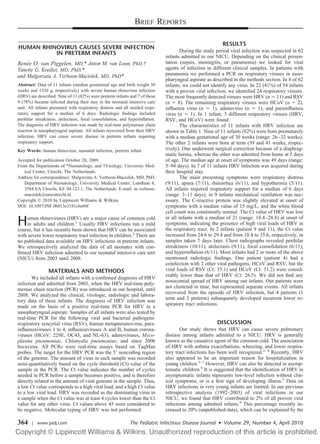

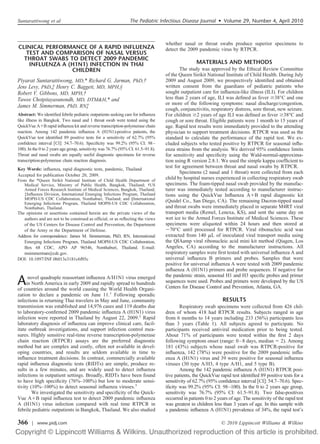

![SHOULD HIGHER VANCOMYCIN TROUGH LEVELS BE
TARGETED FOR INVASIVE COMMUNITY-ACQUIRED
METHICILLIN-RESISTANT STAPHYLOCOCCUS AUREUS
INFECTIONS IN CHILDREN?
Natalia Jimenez-Truque, MQC, MSCI, Isaac Thomsen, MD,
Elizabeth Saye, BS, and C. Buddy Creech, MD, MPH
Abstract: Methicillin-resistant Staphylococcus aureus isolates with van-
comycin minimal inhibitory concentrations (MICs) Ն1.5 g/mL have been
associated with poorer clinical outcomes and treatment failures in adults.
We evaluated vancomycin MICs in 71 invasive pediatric community-
acquired MRSA isolates from 2004 to 2008, using the E-test micromethod
and the E-test macro-method. The modal MIC by micromethod was 1.5
g/mL, and median vancomycin MICs did not increase over time.
Key Words: MRSA, vancomycin, methicillin resistance, Staphylococcus
aureus, pediatric, invasive
Accepted for publication October 8, 2009.
From the Department of Pediatric Infectious Diseases, Vanderbilt Univer-
sity Medical Center, Nashville, TN.
Supported, in part, by Vanderbilt CTSA grant 1 UL1 RR024975 from
NCRR/NIH and Fogarty International Center grant 1 R25 TW007697.
Address for correspondence: C. Buddy Creech, MD, MPH, 1161 21st Ave
South, CCC-5311 Medical Center North, Nashville, TN 37232. E-mail:
buddy.creech@vanderbilt.edu.
DOI: 10.1097/INF.0b013e3181c52a04
Since the emergence of methicillin-resistant S. aureus (MRSA),
vancomycin has been a key antimicrobial agent for the treat-
ment of MRSA infections.1,2
Concerns surrounding the long-term
use of vancomycin as a primary therapy were confirmed when the
first vancomycin–intermediate S. aureus (VISA) isolate was diag-
nosed in Japan in 1996.3
Recently, it was shown in adult patients
that strains with minimal inhibitory concentrations (MICs) Ն1.5
g/mL, though not above the susceptibility breakpoint of 2 g/
mL, were associated with clinical failure.4,5
This increase in
vancomycin MICs over time is defined as MIC creep.6 – 8
Because of MIC creep, tissue penetration of vancomycin,
and other factors, the vancomycin MIC breakpoints were lowered
in 2006. According to these breakpoints, an isolate with an MIC of
Յ2 g/mL is considered susceptible to vancomycin, an isolate
with intermediate resistance has an MIC of 4 to 8 g/mL, and an
isolate with an MIC Ն16 g/mL is resistant. Some bacterial
colonies within the staphylococcal population, on exposure to
vancomycin, develop an intermediately resistant phenotype known
as heterogeneous-vancomycin intermediate S. aureus (hVISA), a
phenotype that may be responsible for treatment failures despite
overall vancomycin susceptibility.2,6
Most data regarding MIC creep has been collected from
adult isolates. It is unclear whether this phenomenon occurs in
MRSA isolates from pediatric patients, specifically those classified
as community-associated MRSA (CA-MRSA). CA-MRSA iso-
lates would be expected to have lower vancomycin MICs when
compared with hospital-associated MRSA isolates due to the lack
of selective vancomycin pressure in the community. We hypoth-
esized that vancomycin MICs have not changed significantly over
time in the pediatric population, because risk factors such as
frequent vancomycin exposure and foreign bodies such as cathe-
ters or prosthetic joints are not likely to be present in children with
CA-MRSA disease. To evaluate this, we studied the vancomycin
MICs for pediatric CA-MRSA isolates from 2004 to 2008 based
on site of infection.
MATERIALS AND METHODS
S. aureus Clinical Isolates. Since 2004, all pediatric CA-MRSA
isolates at Vanderbilt Children’s Hospital have been archived.
Each isolate represents a unique pediatric patient. Isolates are
considered to be CA-MRSA based on application of Centers for
Disease Control-criteria.9
For this study, we analyzed vancomycin
MICs for 71 previously characterized invasive pediatric CA-
MRSA isolates collected from 2004 to 2008 that were viable in
culture and in which site of infection and date were known. These
71 invasive CA-MRSA isolates were randomly selected from a
de-identified pediatric clinical isolate database of 1376 unique
isolates, using a random number generator. In 706 isolates, unam-
biguous notation of site of infection was available; from these, 80
were from patients with invasive MRSA disease, and 71 were
viable in culture and had molecular features characteristic of
CA-MRSA.
Isolates were initially classified as MRSA by the clinical
laboratory of Vanderbilt Children’s Hospital and subsequently
confirmed by our laboratory based on growth on mannitol salt agar
plates containing oxacillin and a positive latex agglutination test
for clumping factor (Staphaurex, Remel). DNA was extracted and
purified and was used as template for polymerase chain reaction
(PCR) detection of nuc and mecA genes and for staphylococcal
cassette chromosome mec (SCCmec) typing, as described else-
where.10
Genotyping of isolates was performed by pulse-field gel
electrophoresis and/or repetitive element sequence based PCR.11
E-Test Micro- and Macro-Methods. S. aureus strain ATCC 29213
was used as the reference strain for both E-test methods (AB-
Biodisk, Solna, Sweden), which were performed according to the
manufacturer’s guidelines. For the micromethod, a 0.5 McFarland
standard was prepared in sterile saline, inoculated onto Mueller-
Hinton agar, and incubated for 24 hours at 35°C. For the macro-
method, a 2 McFarland standard was inoculated onto brain-heart
infusion agar and incubated for 48 hours at 35°C. Testing of the
clinical isolates was done in a single laboratory, and the results
were recorded by a single observer. S. aureus isolates with van-
comycin MICs by micromethod of Յ2 g/mL were considered
susceptible (VSSA) based on Clinical and Laboratory Standards
Institute guidelines. Intermediate susceptibility to vancomycin
(VISA) was defined by MICs of 4 to 8 g/mL, and vancomycin
resistance (VRSA) by MICs of Ն16 g/mL.
Analysis of MICs over time and by site of infection was
performed using the Kruskal-Wallis H method. A P value of 0.05
was considered statistically significant. All analyses were per-
formed with SPSS Version 16.0.
RESULTS
To confirm that each of the 71 isolates clinically determined
to be community-associated were also genotypically consistent
with CA-MRSA, we performed SCCmec typing and genotyping by
pulsed-field gel electrophoresis or rep-PCR. All of the isolates had
SCCmec IV cassette and belonged to USA300, the current epi-
demic clone in the United States. Of the 71 invasive isolates, 47
(66.2%) were from joint infections (Table 1).
Overall, the modal MIC by micromethod was 1.5 g/mL.
Fifty-six isolates had an MIC Ն1.5 g/mL. Three isolates had
an MIC of 2 g/mL, but are considered susceptible by Clinical
and Laboratory Standards Institute breakpoints. Only 15 iso-
lates had an MIC Ͻ1.5 g/mL. Median and mean vancomycin
MICs did not increase over time (P ϭ 0.245, Inter-Quartile
Range [IQR] 1.5–1.5 g/mL). Similarly, MIC values were not
significantly different across different infection sites (P ϭ
0.952, IQR ϭ 1.5–1.5 g/mL).
Jimenez-Truque et al The Pediatric Infectious Disease Journal • Volume 29, Number 4, April 2010
© 2010 Lippincott Williams & Wilkins368 | www.pidj.com](https://image.slidesharecdn.com/66a8da09-39a4-42de-a83b-bccf25bbe703-161129162346/85/3335-Ext-Val-p374-5-320.jpg)


